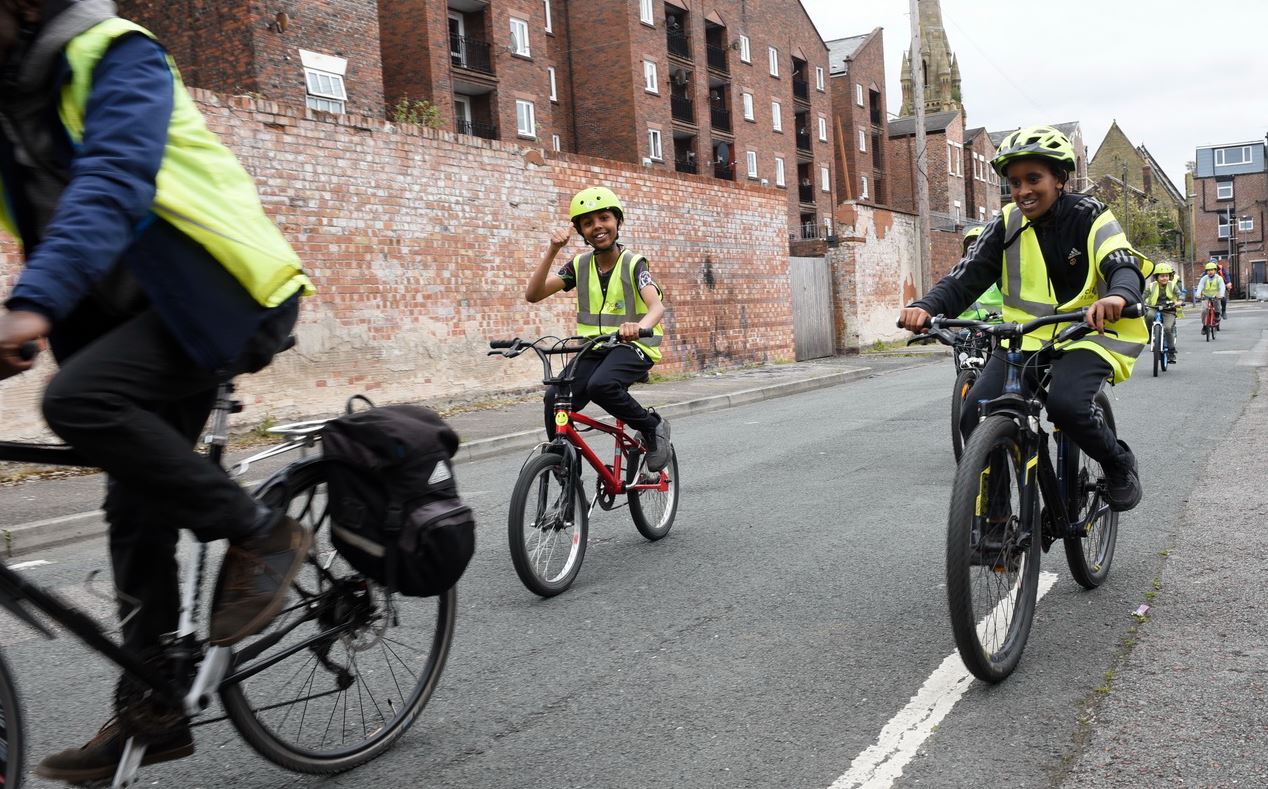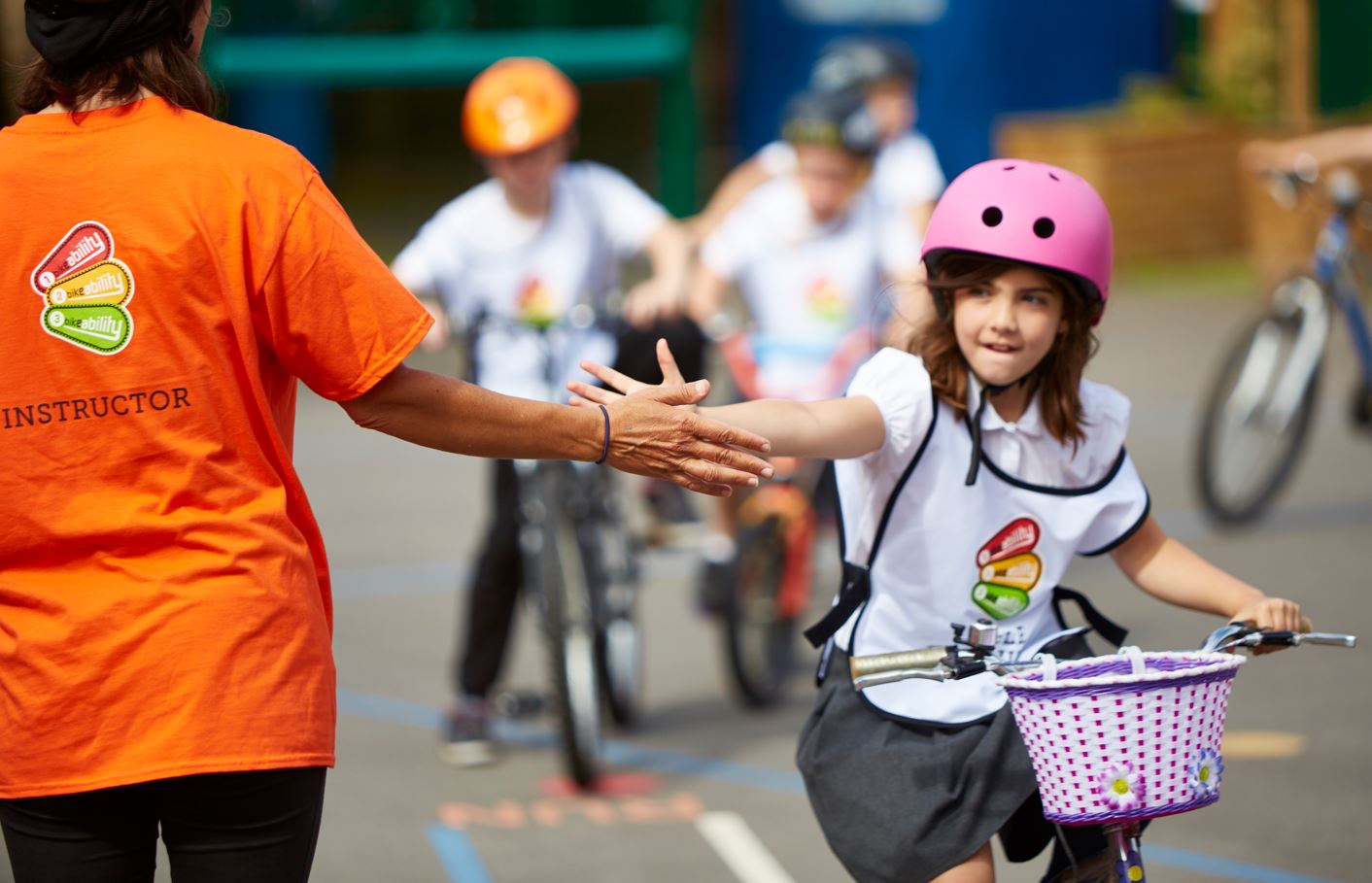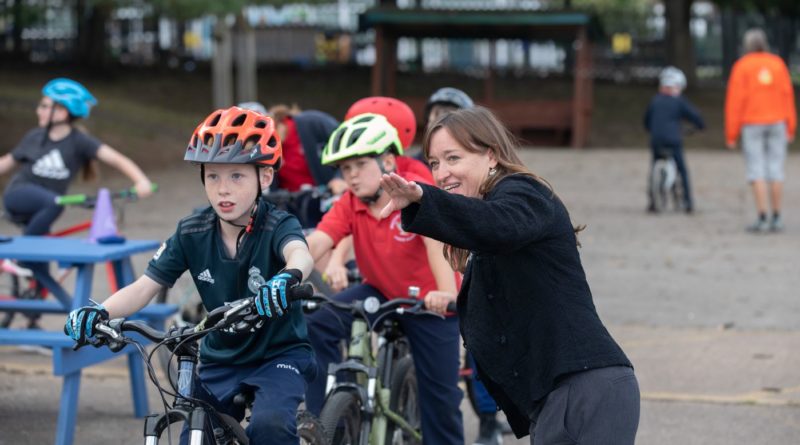Make cycle training a statutory requirement for kids, says Bikeability CEO
Like countless other ambitious organisations, Bikeability has big ideas and is determined to deliver new strategies to see cycling maintained past the school gates. CEO Emily Cherry talks to CI.N about funding struggles, engaging parents with cycle training and getting creative to maintain interest with teenagers…
From the language in the Gear Change document you could be forgiven for thinking that Bikeability is a given for every child, at every stage of schooling and for many adults in the UK too. “The Government has a manifesto commitment to offer Bikeability training to every school child,” proclaims the document, adding “this commitment would extend to any adult that wanted cycle training.”
Arguably it should be a given and as funding has steadily unfrozen for active travel it’s a case that has been made with increasing vigour by those heading up the cycle training organisation. In the CEO role at the Trust that oversees Bikeability since the spring of 2020, Emily Cherry makes a comparison that will make sense to every person who has passed through the education system in the past few decades.
“As Secretary of State for Education, Nadhim Zawahi put Bikeability on the curriculum as part of education related to climate change and sustainability. That was a big step. We’re grateful for that and we will push further for a statutory requirement, the same sort of statutory requirement that is in place to teach kids to learn to swim by year 6. We think lifesaving skills such as this are important and Bikeability is a life skill in road safety.”
Most of us in the bicycle industry will have recollection of either a cycling proficiency test, or Bikeability training, but if you do then you may be one of the lucky ones. It turns out that the current available funding only covers 44% of children by year 6 and only 60% of primary schools are taking up the opportunity to have kids trained.

“It’s true to say we are not actually fully funded,” starts Cherry. “In 2016 cycle training for kids became a subsidy, but all local authorities are expected to contribute to the cost.”
This explains how a recent headline from North Yorkshire that detailed how parents had been asked to contribute funds for training came to pass. Last year the authority received £46.20 per pupil, but this time around the funding pot came up short, £90,000 short.
Furthermore, during July and apparently in response to its severe funding shortfall, Transport for London slashed its cycle training budget to zero, leaving kids in London massively disadvantaged against the nationwide picture; and in a city where the infrastructure makes cycling to school safer than many places and thus most likely to have a lifelong effect on transport habits. Worse still, this move has left plenty of cycle instructors without the work they enjoy.
Emily explains “Some local authorities choose not to take an admin cut and give all funding direct to the provider. North Yorkshire’s in-house team have higher costs, so they have control locally of how they roll the contract out. The grant funding per head model rose in 2021, but hadn’t been changed for 14 years prior. It is up to local authorities how they spend the cash. It is the case that other local authorities also charge parents and carers, but latterly use the cash to expand upon the training available.”
With the second Cycling and Walking Investment Strategy now out in the wild, the question of future funding requires attention. Cycling UK’s policy director has already derided the gap between ambition and funding as having a “glaring mismatch”. Is this the case for Bikeability’s ambition and its funding, we ask?
“I welcome the record investment, of course. Now, is it sufficient and do we in cycling want greater parity on the road budgets? Of course we would. If we are truly serious about Net Zero, reducing carbon and getting walking and cycling to 50% journeys, well then what we have is only a start and not enough, nor fast enough. I dream of a structure where every child is trained consistently throughout their schooling life. To do that we would easily need to double the budget. This is without talking about adults too. At the moment this training is done through other local authority funding streams. We don’t currently look after this budget, but we would like to take that responsibility,” says Emily, echoing Roger Geffen’s sentiment.
 The current funding structure does not go past April 2023 and while that may even have changed by the time this magazine lands on doorsteps thanks to Government reshuffling, Emily says “we hope to confirm a further two-year settlement urgently. It has to be at least the same level at £20 million, which is still a way off every child being covered.”
The current funding structure does not go past April 2023 and while that may even have changed by the time this magazine lands on doorsteps thanks to Government reshuffling, Emily says “we hope to confirm a further two-year settlement urgently. It has to be at least the same level at £20 million, which is still a way off every child being covered.”
Running the numbers, we’re told that with the current budget 500,000 children can be trained, which “is not even a single year group (approx. 650,000); there are 8.5 million children in education,” explains Emily, adding “Our dream is to have children aboard balance bikes in reception, teach basic ride skills in year one and two, a level one course in year three to four and level two in years five and six. That’s long-term vision, all being well.”
With that achieved, the skill level would be comprehensive by the time kids hit a new stage of life and one where new challenges emerge to keep kids on bikes. Worryingly, the national trend for cycling to school drops off as kids leave primary and move to secondary education. Why is that?
“I think you cannot underestimate the effect of peer pressure and how the perception of body image affects young people too. The image of cycling, is it cool to teenagers? We think from our feedback that Bikeability is perceived as such a good thing at primary by the kids, but it’s true to say that we need a different brand image for teenagers to take notice. That means we are embarking upon creating a new language and investing in a rebrand for our teenage offering.”
Part of that effort to keep teenagers engaged spans right through to driving age and includes outreach efforts to keep the learning process about cycling and cyclists running right through all road education.
“We have a cycle savvy driving pilot that is training approved driving instructors so that when people are taking lessons they develop an understanding and respect of the road user hierarchy, responsibility and other safety elements,” explains Emily on another of the organisations non-traditional projects.
All projects that help people see the other’s perspective have been helpful, we’re told. Emily adds on driver awareness that “with the approved driving instructors we hear feedback that the process has been transformative and helpful; many see road use in different light thereafter. Safer urban driver and lorry courses also help on fringes. Sometimes our instructors do those courses for a different perspective. Lorry drivers can often be forced on courses, maybe they don’t want to be there, but the employer asked. We find that by the end they have transformed how they look at behaviours and understand why cyclists sometimes ride on inside, or turn the way they do.”
Specifically on engaging more girls in cycling, said to be among the greatest challenges for Emily’s team, the work is likewise to hit a new gear.
“Because we know body image big for teen girls we have invested in widening participation funds towards projects to tackle this trend. I am soon to visit one that’s been live for 18 weeks that has looked at confidence, social and emotional work. We have invested in 44 such projects and I think they’ll make a big difference.”
Parents have a role to play too, we’re told. Acknowledging its limitation, Bikeability is keener than every to engage parents and carers, knowing that without direct contact with the training there may linger a fear of letting a child cycle on the roads.
“Parents and carers hold the key to the bike shed, so they can also be the number one drop off cause. Those that remain fearful of road conditions will not encourage continued cycling. So, we are planning on more work with parents and carers so they understand what has been taught and how it can impact a child’s life,” says Emily.
On this note it is revealed that a new mobile app that delivers up to date information on a child’s Bikeability progress will soon be offered. Through this virtual parent and carer hub digital badges and awards will be handed out and, aligning to other goals of the organisation, further engagement in cycle training, or events, could be promoted alongside.
“This is partially why we want to invest more in family courses. We have grant funding to see 5,000 households of up to six people. That’s personal, bespoke time as a household with an instructor for up to three hours. Parents can therefore see the confidence in their kids, and we can upskill the parent themselves. If a family came to us wishing to practice a child’s journey to secondary school, we could plan the route and talk about hazards before riding it together. As a parent that’s a huge confident booster, largely because they themselves have done it,” adds Emily.
There are more out of the box ideas in motion to really drive cycling appeal in a genuine way, we learn. Bikeability is to head to the pump track in a bid to add a layer of adrenaline into skills training. Cog, a Waltham Forest community group is one such partner introducing kids to BMX on its pump track.
“With this method children’s levels of concentration, peer communication and learning is high. I’m a big fan of doing things in a different way. On that note, we are also working to develop an immersive reality cycling concept, one where participants use a static bike, but with an immersive, 360-degree gamified experience delivered via eye-tracking glasses. Obviously, the kids love it. Brunel University and Dr Dan Bishop helped us develop the idea. We hope to have a national scale up later in the year and hopefully an industry partner to help us roll this training concept out.”
With electric scooters looking set for legislative approval in terms of private ownership use on the roads and cycle paths, Bikeability also has eyes for how this new transport form could capture children who prefer it to cycling. With that in mind, to understand the potential, in Bournemouth, in partnership with Beryl, Bikeability has done some conversion courses with its to teach safe eScooter use.
“Our pitch to Government is that training in future can cover micromobility. We have professional instructors who say that the teaching we give is fit for purpose in this space. The aim would be to offer this from 14 and above,” explains Cherry.
So, with traffic looking busier on the roads for all things two and four wheel, what happens when road users are forced closer together and for motorists to pay attention more than usual for vulnerable users who have not traditionally been there as often? Safe infrastructure, as demonstrated successful to stimulating ridership wherever present globally, is critical too.
“Two years ago Sustrans survey work shower that almost 80% of parents saw unsafe roads as the greatest barrier to cycling,” says Emily.
Familiarisation with road infrastructure must nonetheless take place and to be able to offer such training in a safe environment segregated from the road is extremely helpful, where such facilities exist.
“We think enclosed cycling spaces are critical and we support places like the Wheels for All Adapted Cycling Centres, as seen in Colchester. This is a brilliant cycling track, which has fake roads, T-junctions and a sports track too. The Wheels for All inclusive cycle training charity has adapted cycles, again crucially for engagement. There we can work with adults with learning difficulties and disabilities. We need more of these centres to create a broad and diverse modal share,” Emily explains.
At this point a helping hand from the bike industry is called for. There exist a number of bike businesses actively involved in advocacy efforts, sometimes even direct efforts, to develop children’s cycling in a local area. Could more support from the industry be provided, however?
The greatest help would be to help Bikeability level up on opportunities for a wider crowd, says Emily.
“I would love to see more partnerships with the bike industry looking at recycling schemes for deprived areas whereby bikes could be repurchased at cost for disadvantaged children. I wonder how many cycle shops could do a communications campaign about old bikes sat in garages, then give those safety checked bikes to us to work with. All bikes would be welcome for donation, helping us train people.”
 A severe shortfall of instructors
A severe shortfall of instructors
Recruitment has been a turbulent matter for most over the past few years and the effects of finding the right people are no less felt by the cycle training organisation.
“We’ve got around 3,000 instructors currently through a network of 195 providers. To meet our goals we have done workforce modelling to grow that number to 4,500 in the next 18 months and so we have a 1,500 person shortfall; this is critical to address. We have launched 1,250 training bursaries and that pays for professional training as a level two cycle instructor. So far we have only found 300 individuals. We are slowly getting there with lots of targeted recruitment on social channels, but we are struggling to get people to come forwards,” says Emily.
The qualification is useful in terms of career progression, we’re told. Becoming a Level Two trainer adds an Ofcol recognised qualification that ups a person’s ability to work in a broader range of industries.
“Instructor skills are prized. Delivery companies wish to use qualified cyclists, for example. ZipCar like to employ proven safe road users. We are looking at recognising prior learnings from other sports coaches who know how to engage children as part of our work so that these things work both ways. I’d like to see more 16 to 18 years olds looking at a sport career get in touch, but also we don’t have gender parity, nor ethnicity parity by a big margin, so we want to see broad community representation as that’s a great way to build deeper community engagement into places where we have not been so successful before,” concludes Emily.



